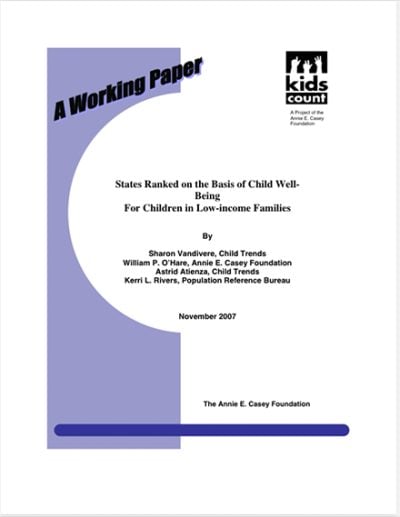Summary
The Annie E. Casey Foundation’s KIDS COUNT® project has ranked the 50 states based on overall child well-being each year since 1990.
Taking a Closer Look at Kids in Low-Income Families
In this paper, researchers use data from two sources — the American Community Survey and the National Survey of Children’s Health — to create comprehensive state-level indices of how children in low- and higher-income families are faring. When reporting state-level data on child well-being, limiting the view to low-income families can help assess a state’s capacity to support children in need.
About the Study
This study defines low-income families as those with incomes below 200% of the federal poverty threshold. Higher-income families are all families with incomes that exceed this threshold.
It aims to answer two basic questions:
- In which states are the children in low-income families the best?
- Which states have the biggest differences between the condition of children in low-income families and those in higher-income families?
Findings on Child Well-Being
This assessment of state-level child well-being data suggests that:
- States that rank best in child well-being in low-income families are clustered in the upper Great Plains and Rocky Mountain regions. These states are: 1) Utah; 2) North Dakota; 3) Idaho; 4) Wyoming; and 5) South Dakota. Among the top-10 ranked states, only two — Vermont and Hawaii — are not in this region.
- States that rank last in child well-being in low-income families are clustered on the East Coast and Mid-Atlantic region. These states are: 50) Massachusetts; 49) Rhode Island; 48) New York; 47) New Jersey; 46) Maryland; and 45) Delaware.
- Rankings do not hold when comparing how a state ranks in low versus higher-income child well-being. In 17 states, the rankings for children in low-income versus higher-income families differed by more than 10 spots. This suggests that rankings based on a state’s entire child population can mask important differences among groups of children within a given state.
- States with the biggest difference between rankings for children in low-income families and those in higher-income families were: 1) Massachusetts (29 spots); 2) Washington (27 spots); 3) New Mexico (26 spots); 4) Connecticut (24 spots); and 5) California and Alaska (23 spots).
- Five states where the rankings for low-income children ran much higher than the rankings for higher-income children are: 1) Washington; 2) New Mexico; 3) Alaska; 4) California; and 5) Hawaii.
- Five states where the rankings for low-income children ran much lower than the ranking for higher-income children are: 1) Massachusetts; 2) Connecticut; 3) Ohio; 4) North Carolina; and 4) Kentucky.
- When examining the condition of children in low-income families, many states in the Deep South — including Mississippi, Louisiana, Alabama, and Arkansas — remain in the bottom half of the rankings but do not dominate the very bottom of these rankings.
About the Series
This publication is part of the KIDS COUNT Working Paper series,
which elevates discussions about data gaps, results and trends related
to the KIDS COUNT database.







